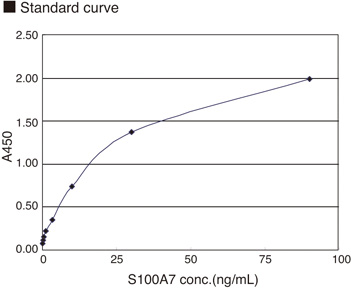CircuLex S100A7/Psoriasin ELISA Kit
Product Code:
MBL-CY-8073
MBL-CY-8073
Regulatory Status:
RUO
RUO
Application:
Enzyme-Linked Immunosorbent Assay (ELISA)
Enzyme-Linked Immunosorbent Assay (ELISA)
Shipping:
4°C
4°C
Storage:
4°C
4°C
No additional charges, what you see is what you pay! *
| Code | Size | Price |
|---|
| MBL-CY-8073 | 96 Assays | £602.00 |
Quantity:
Prices exclude any Taxes / VAT
Stay in control of your spending. These prices have no additional charges, not even shipping!
* Rare exceptions are clearly labelled (only 0.14% of items!).
* Rare exceptions are clearly labelled (only 0.14% of items!).
Multibuy discounts available! Contact us to find what you can save.
This product comes from: United States.
Typical lead time: 10-14 working days.
Contact us for more accurate information.
Typical lead time: 10-14 working days.
Contact us for more accurate information.
- Further Information
- Documents
- References
- Show All
Further Information
Background:
Human Psoriasin was first identified as an over-expressed secreted protein in psoriatic skin (1). Psoriasin also called S100A7, is distributed in the cytoplasm of keratinocytes in normal human epidermis and is present at the cell periphery in terminally differentiated keratinocytes (2). The peripheral distribution observed in differentiated cells may be important, since, under some conditions, S100A7 may be released from keratinocytes. Several S100 proteins are thought to be secreted (3-5). Indeed, S100A7 has been shown to function as a chemotactic agent and as a cytokine (6, 7), and to attract CD4+ lymphocytes and neutrophils (7). Originally characterized as a marker of psoriasis, S100A7 overexpression is seen in many epidermal inflammatory diseases, including atopic dermatitis, mycosis fungoides, Darier's disease, and inflammatory lichen sclerosus at atrophicus (1, 2, 8). The high level of expression in active psoriatic lesions has prompted investigators to suggest that S100A7 may have a chemotactic role in psoriasis (7). S100A7 expression is also increased in invasive skin cancers such as squamous cell carcinoma, and squamous carcinoma in situ, but not in basal cell carcinoma (9).
It should be noted that 11-kD S100A7 protein purified from skin extract preferentially killed the gut bacterium Escherichia coli, but had little or no activity against Staphylococcus aureus or other bacteria (10). The activity could be inhibited by zinc, but not by other bivalent ions, suggesting that S100A7 kills E. coli by sequestration of zinc. Immunohistochemical analysis demonstrated intense expression of S100A7 in healthy skin, particularly in the face, scalp, and sebaceous glands. Real-time PCR and ELISA analysis of keratinocytes stimulated with E. coli culture supernatants revealed induced transcription of S100A7 and its secretion. Stimulation with IL-1 beta or, to a lesser extent, with TNF alpha also induced S100A7 transcription and secretion. These results indicated that S100A7 is key to the local innate defense against E. coli on body surfaces and kills the bacteria by sequestering essential transition metal ions (10).
Description:
The CycLex Research Product CircuLex S100A7/Psoriasin ELISA kit is used for the quantitative measurement of human S100A7/Psoriasin in washing fluid from skin, nIPle fluid, tissue culture medium and other biological samples probably including serum, plasma.
Gene IDs:
Human: 6278
Kit Components:
Microplate,10X Wash Buffer, Dilution Buffer, Human S100A7/Psoriasin Standard, HRP conjugated Detection Antibody, Substrate Reagent, Stop Solution
Measurement Range:
Dilution factors need to be taken into consideration in calculating the human S100A7/Psoriasin concentration. Results exceeding human S100A7/Psoriasin level of 90 ng/ml should be repeated with diluted samples.
Sensitivity:
better than 0.12 ng/ml of sample.
Target:
S100A7/Psoriasin?????????
Documents
References
1. Madsen P, Rasmussen HH & Leffers H et al. Molecular cloning, occurrence, and expression of a novel partially secreted protein "psoriasin" that is highly up-regulated in psoriatic skin. J Invest Dermatol (1991) 97: 701?712.
2. Broome AM, Ryan D & Eckert RL. S100 protein subcellular localization during epidermal differentiation and psoriasis. J Histochem Cytochem (2003) 51: 675?685.
3. Hitomi J, Yamaguchi K & Kikuchi Y et al. A novel calcium-binding protein in amniotic fluid, CAAF1: Its molecular cloning and tissue distribution. J Cell Sci (1996) 109: 805?815.
4. Katz AB & Taichman LB. A partial catalog of proteins secreted by epidermal keratinocytes in culture. J Invest Dermatol (1999) 112: 818?821.
5. Karimi-Busheri F, Marcoux Y & Tredget EE et al. Expression of a releasable form of annexin II by human keratinocytes. J Cell Biochem (2002) 86: 737?747.
6. Hoffmann HJ, Olsen E & Etzerodt M et al. Psoriasin binds calcium and is upregulated by calcium to levels that resemble those observed in normal skin. J Invest Dermatol (1994) 103: 370?375.
7. Jinquan T, Vorum H & Larsen CG et al. Psoriasin: A novel chemotactic protein. J Invest Dermatol (1996) 107: 5?10.
8. Algermissen B, Sitzmann J, LeMotte P & Czarnetzki B. Differential expression of CRABP II, psoriasin and cytokeratin 1 mRNA in human skin diseases. Arch Dermatol Res (1996) 288: 426?430.
9. Alowami S, Qing G & Emberley E et al. Psoriasin (S100A7) expression is altered during skin tumorigenesis. BMC Dermatol (2003) 3: 1.
10. Glaser, R.; Harder, J.; Lange, H.; Bartels, J.; Christophers, E.; Schroder, J.-M. Antimicrobial psoriasin (S100A7) protects human skin from Escherichia coli infection. Nature Immun. (2005) 6: 57-64



